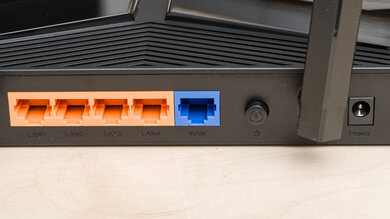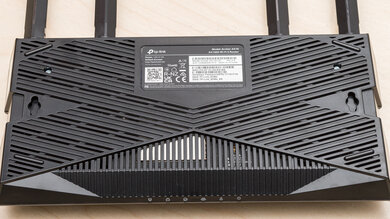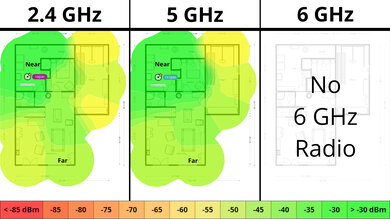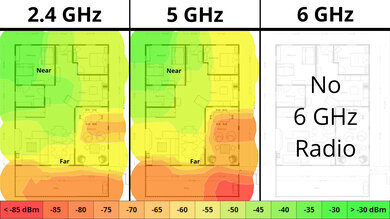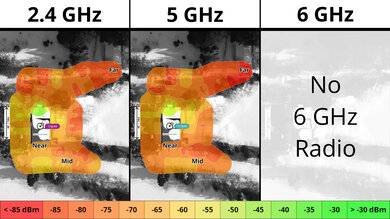The TP-Link Archer AX10, is a dual-band Wi-Fi 6 router with 2.4GHz and 5GHz bands. It supports WPA3 security and OneMesh technology, allowing you to configure a mesh network with one of TP-Link's Wi-Fi extenders. You can set up and manage the router using TP-Link's Tether app or the web interface, where you can also configure parental controls.
Our Verdict
The TP-Link Archer AX10 is a decent router if you live in an apartment, condo, or single-story home. It delivers good speeds across a single floor and is suitable for most internet uses, such as video calls and 4k streaming. It also has decent wired connectivity with four 1Gbps LAN ports. It's a reasonable size that will fit into most living spaces, and it also has screw head slots on the bottom, so you have the option to mount it on the wall or ceiling.
-
Good top speeds.
-
Decent range.
-
Wi-Fi 6 won't take full advantage of new Wi-Fi 6E or 7 devices.
-
Lacks DFS support, so it can't avoid more congested channels.
The TP-Link Archer AX10 is a reasonable router if you live in a multi-level house. It provides speeds fast enough for most internet uses throughout your home, like 4k video streaming and downloading large files quickly. Still, it's a standalone unit, so you might experience dropouts depending on your home's size, layout, and construction. Thankfully, you can add one of TP-Link's OneMesh Wi-Fi extenders to create a mesh network with better range.
-
Good top speeds.
-
Decent range.
-
Compatible with OneMesh devices to create a mesh network for better range.
-
Wi-Fi 6 won't take full advantage of new Wi-Fi 6E or 7 devices.
This router delivers good speeds suitable for an internet connection of up to ~600Mbps. However, it doesn't support DFS (Dynamic Frequency Selection), so it can't access DFS-only channels, which would help its speeds in congested wireless environments.
-
Good top speeds.
-
Wi-Fi 6 won't take full advantage of new Wi-Fi 6E or 7 devices.
-
Lacks DFS support, so it can't avoid more congested channels.
This router has decent range. It's a standalone unit, so it's slower the further away from it you are, but you can add a OneMesh-compatible range extender to improve its range.
-
Decent range.
-
Compatible with OneMesh devices to create a mesh network for better range.
-
Wi-Fi 6 won't take full advantage of new Wi-Fi 6E or 7 devices.
Changelog
- Updated May 01, 2025: We've converted this review to Test Bench 0.8.1. This includes a new test result for our Test Configuration box.
-
Updated Jan 21, 2025:
Mentioned the TP-Link Archer AXE75 as a Wi-Fi 6E alternative in the Wi-Fi Specifications section.
- Updated Jul 22, 2024: Review published.
Check Price
Differences Between Sizes And Variants
The TP-Link Archer AX10 has a nearly identical variant, the TP-Link Archer AX1500. The main difference between the two seems to be that the AX10 is compatible with TP-Link's OneMesh, while the AX1500 isn't. If you have the TP-Link Archer AX1500 and know of any other differences or would like to share your experience, let us know in the comments.
Here's a link to our unit's label.
Compared To Other Routers
The TP-Link Archer AX10 is a mainstream Wi-Fi 6 router in a competitive lower mid-range price bracket. This router offers features like the newest WPA3 security standard, support for TP-Link's OneMesh technology for connecting range extenders, beamforming, OFDMA (Orthogonal frequency-division multiple access), and more.
It offers network coverage performance and features similar to those of other Wi-Fi 6 routers in its price category. Notably, it performs similarly to the higher-end TP-Link Archer AX20 and slightly better than the ASUS RT-AX1800S and the TP-Link Archer AX21. It's a good choice if you want a solid-performing router and haven't yet upgraded many devices to a newer Wi-Fi standard like Wi-Fi 6E or 7.
For more recommendations, check out the best Wi-Fi 6 routers, the best Wi-Fi routers, or the best routers for streaming.
The TP-Link Archer AX21 and the TP-Link Archer AX10 are standalone Wi-Fi 6 routers. The AX10 is a budget router, while the AX21 is a lower mid-range model. The two perform very similarly, but the AX10 has a slightly better range.
While the TP-Link Archer AXE75 is a tri-band Wi-Fi 6E router and the TP-Link Archer AX10 is a dual-band Wi-Fi 6 router, they deliver similar performance overall. Therefore, the main advantage of the AXE75 over the AX10 is in noisy wireless environments like apartment or condo buildings, as it has access to the less congested 6GHz band and support for DFS. Otherwise, both routers are compatible with other TP-Link models with OneMesh technology, which makes them configurable as a mesh network to improve coverage and performance in larger environments like a multi-story home.
Test Results
This is a standalone router, so the mesh satellite position line on this graph isn't applicable.
This is a standalone router, so the mesh satellite position line on this graph isn't applicable.
If you'd prefer a Wi-Fi 6E router that grants you access to the 6GHz band for faster speeds and less signal interference, consider the TP-Link Archer AXE75.
Comments
TP-Link Archer AX10: Main Discussion
Let us know why you want us to review the product here, or encourage others to vote for this product.
Update: We’ve converted this review to Test Bench 0.8.1. This includes a new test result for our Test Configuration box.



